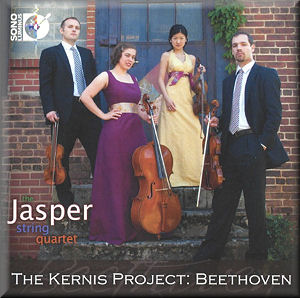 |
 |
|


alternatively
CD: MDT
AmazonUK
AmazonUS
Sound
Samples & Downloads |
The Kernis Project
Ludwig van BEETHOVEN (1770-1827)
String Quartet No 9, Op 59 No 3, “Razumovsky” [32:24]
Aaron Jay KERNIS (1960-)
String Quartet No 2, “musica instrumentalis” [38:48]
 Jasper String Quartet
Jasper String Quartet
rec. 7-9 May 2011, Sono Luminus, Boyce, Virginia, USA
 SONO LUMINUS DSL-92142 [71:12]
SONO LUMINUS DSL-92142 [71:12]
|
|
|
Don’t let the clunky title or the awkward cover photo put you
off: this is a fabulous disc. Its virtues are manifold: the
bold programming of one of Beethoven’s Razumovsky quartets with
a 1998 work inspired by the Beethoven and written by Aaron Jay
Kernis, the verve and energy of the Jasper Quartet, and the
demonstration quality of the Sono Luminus sound. This is an
urgent purchase for chamber music lovers.
Where to start? The Jasper Quartet members say that they formed
over a mutual love of Beethoven’s quartet in C, Op 59 No 3,
that it was the first work they presented in concert, and that
furthermore they have played it on “the top of a mountain”:
Sulphur Mountain in Alberta, Canada, where, says first violinist
J Freivogel, “our fingers got quite cold”. I believe it all.
This is a fantastic performance in every respect: the four players
are very much equals, and they play with a gratifying combination
of tonal polish and energetic enthusiasm. There are no rough
edges or lapses in interpretive prowess. I will readily believe
their claim to have banded together for the sake of this work,
because if there is any word to describe the Jaspers’ playing
in the outer movements, it is to say that they are reveling
in it. The poignant andante contains no reveling, but there
is no less heart.
Aaron Jay Kernis’ second quartet, “musica instrumentalis,” has
but one major weakness, which is a predilection for goofy movement
titles, heralded by Kernis’ uncapitalized name for the work.
The first movement is a lengthy “Overture” which sometimes recalls
the Beethoven in tone - vigorous, bustling activity with occasional
optimistic, even sweet interludes. The second movement comprises
two sarabandes, oases of calm, coupled with rather gratuitously
gnarly, hostile transitional passages. They’re worth it for
the absolute peace we feel at passages like those which begin
around 4:00 and 8:00, and for the ultimate sense of a really
important emotional journey.
It’s all capped quite satisfyingly by the finale, the best movement
despite its clumsy title: “Double Triple Gigue Fugue.” Kernis
tells us in his own note that this section does indeed contain
a double fugue, a triple fugue, a gigue, and an unadvertised
tarantella, all rolled up in both rondo and sonata forms (!).
I’m not sure I am really prepared to believe this, but my ears
need no study of the score to confirm that the movement is a
winner. It’s highly sophisticated and rounds off the quartet
well, but is more conventionally tuneful than the others. There
are some Beethovenian gestures and developmental procedures
— intentional, since Kernis’s inspiration for the movement is
the Beethoven quartet which was the CD’s first half. At moments
you can hear an upside-down version of Op 59 No 3’s fugal subject
being given its own fugal treatment.
If there’s any fault to the score, it’s the length (over 38
minutes); the Overture definitely feels finished after a big
pause five minutes in, though Kernis then conjures up a really
wonderful melody and revives my interest. The coda of that movement
is really invigorating, too - imagine an American Janác(ek -
so maybe my quibble about the length is a quibble about my inability
to see how point A leads to point B. That doesn’t change the
fact that this is generally good and often extraordinary music.
It gets better as it goes along, bold in tone, confident in
sound, and absolutely convincing in its emotional structure.
It is delivered with great power by the Jasper players.
So this album has something for everyone, with exceptionally
well-played Beethoven and a contemporary sharing in the Beethovenian
spirit, by turns knotty and thrilling. This is the Jasper String
Quartet’s debut, and one must hope that much more is to come.
Indeed, that bizarre title, “The Kernis Project: Beethoven,”
suggests that more is to come. After all, it would be a grammatical
faux pas if it wasn’t immediately followed up by, say, “The
Kernis Project: Barber,” coupling Aaron Jay Kernis’ String Quartet
No 1 “musica celestis” with another American quartet featuring
a heart-tugging adagio, Samuel Barber’s. They could add Barber’s
rare Serenade, Op 1 to bring the playing time up to an hour.
And then, based on the sheer joyous energy the Jasper Quartet
gives off like sparks, I’d suggest they commission something
from Kernis inspired by Dvorák, Haydn, or even jazz. I would
buy it. This playing is absolutely first-rate.
Brian Reinhart
|
|

